Adventure
 'I believe any trip in search of wildlife can be coupled with physical activity and elements of cultural diversity to form a thrilling opportunity ' 'I believe any trip in search of wildlife can be coupled with physical activity and elements of cultural diversity to form a thrilling opportunity '
John H.Eickert
A long, long time ago and a short distance from where I sit now is a wooded pasture. As a boy, I would sneak away during the sweltering August heat to sit high in an umbrella shaped cottonwood tree and watch the cattle
feeding through the long grass along a creek. In August, the bulls would bellow, push, and shove as they positioned themselves for the best cows. The man who owned the cattle and the pasture named the largest of the bulls ‘Ferdinand’. Ferdinand was big and
fierce; he was always ready to fight the younger bulls for dominance. He was all black except for the tip of his nose, which was brown.
Ferdinand spent most of August fighting the younger bulls while I spent August watching the many battles. Of course, as a small boy I was not allowed to be in the pasture alone and if caught a battle would ensue at
home, with my Mother always winning.
And so, I was walking along the crest dividing the Western Ghats with the Eastern Ghats on a path through tall grass in Bandipur. I snuck into a closed area of the park, walking in the dark; afraid to use my headlamp
fearing the light would attract a park ranger. The sun rose and the mountains came alive. Suddenly I heard the sound of trampling hooves and heavy breathing. I crept through the forest until I could see into the glade beyond. Two Gaur bulls were fighting!
They were covered with sweat as they pushed back and forth. One seemed older, larger, and more thickly muscled, while the other smaller but with great stamina. The Gaur is the largest of the existing wild oxen, adult males weighing more than a tonne. They
are a rich red brown in color and can appear black after sweating.
The Gaur is rapidly disappearing in most of its range in India, but is locally common in the south and northeast. Eventually, the two bulls parted, one lay down, and the other ran off. The path I was on took me directly
past the bull that was lying down. As I passed, I could not help but note his dark hide and brown nose. Memories of Ferdinand flooded into my mind and I whistled from the pleasure as I made my way back through the park. Just as I made it to the main road,
two rangers pulled up and gave me a good dressing down for being in a closed area. They escorted me out of Bandipur. I felt lucky to not have been arrested.
Which of the great bull Gaur of Bandipur won the battle? Clearly, I lost the battles with my Mother and the park rangers. I can’t remember ever seeing Ferdinand lose and would prefer to keep my childhood memory that way. That morning, alone on the crest of
the Ghats, the smaller Gaur broke and ran, while the older bull flopped exhausted in the tall grass, the victor.
( Photograph of Indian Gaur: Aditya Singh)
Visit
http://www.numbum.net or call NumBum Adventurers at 406-777-2228
|
Answers To Quiz Of The Month
This month no one has given all right answers. trishant@rediffmail.com has given 8 right answers.
Right Answer toQuiz on history of National Parks of India
|
| 1.To the indiscriminate slaughter to which wild animals were subjected to prior to the 1920s, the idea of the …………………..was born. |
|
game sanctuary |
national park |
forest reserve
|
|
| 2.The Bombay Natural History Society was formed in ……….to promote the conservation of wildlife. |
|
| 3.The Wildlife Act of 1912 specified |
|
the closure and opening of the sanctuary be left to local government |
closure of the sanctuary during breeding time |
the grant of awards for slaughter of noxious animals and birds
|
|
| 4.The destruction of priceless works of art such as old temples or magnificent buildings would not be tolerated by public opinion, but it is curious that in India of all the places, where
animal life is often sacrosanct to an extraordinary degree, the extirpation of her fauna continues without any public outcry." Who wrote these words in 1936? |
|
Col. A.I.R Glasfurd |
S.H.Prater |
Stanley Jepson
|
|
| 5.The local secretary of the united Provinces Branch of the Preservation of the fauna of the Empire Society was |
|
Capt. Lioonel Hearsey |
F.W Champion |
Major Jim Corbett
|
|
| 6.The idea that a country should preserve unspoilt and unexploited, its natural grandeur, gave the world its first national park in 1872- this was |
|
Kanha National Park, India |
Serengetty National Park , Tanzania |
The Yellow Stone National Park, U.S.A
|
|
| 7.India`s oldest national park is |
|
| 8.India has ------------number of tiger reserves |
|
| 9.In only two regions-Manas (India & Bhutan) and the Sunderbans ( India & Bangladesh) have more than ………….sq.km set aside for tiger reserves |
|
500 sq.km |
1000 sq.km |
2000sq.km
|
|
| 10.In its number of mammals threatened with extinction, India ranks |
|
4th in the world |
6th in the world |
3rd in the world
|
|
Please try our quiz for the current month onBird Sanctuaries of India
|
Burning Issues
Compiled by Dr.Susan Sharma
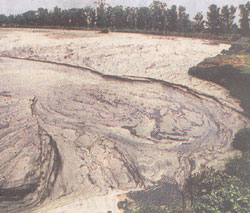 |
A fly ash pond on the banks of the Yamuna. Fly ash, a residue of coal used for generating power at Delhi's Rajghat and Inderprastha plants, finds its way into the river when it is in spate. This photo by Harish Tyagi appeared in theTimes
of India dated June 7, 2001. In the 1970s the Yamuna had a bird life as colourful as the Bharatpur bird sanctuary. |
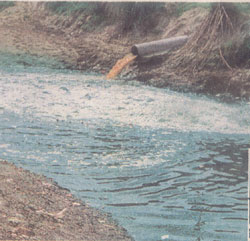 |
Untreated effluents pour into the Western Yamuna canal from a Yamunanagar factory; the industrial belt.
This photo by P.N.Pandey appeared in the Indian Express dated March 10, 2003
Ammonia, the largest pollutant, is being released by sugar factories, paper mills and distilleries. Pulping and bleaching in paper mills requires large amounts of chlorine which mixes with other chemicals to form dioxins and furans.
|
 |
The stretch of Yamuna near the Wazirabad Water treatment plant takes in flowers, ashes, idols and other puja materials wrapped in plastics. This photo by an unknown photographer appeared in theTimes of India after the 2003
Dusshera festival. |
 |
A group of Greater Adjutant storks look for food in a polluted wetland area in Guwahati. Lack of proper garbage dumping facilities in the city is endangering the environment as well as wildlife.
This photo by Ritu Raj Konwar appeared in The Hindu of June 6, 2004
|
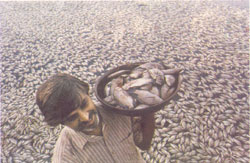 |
Dead fish at the Kankaria lake in Ahmedabad. This photo by AP appeared inThe Hindu dated October 13, 2004.
The mass death has been blamed on chemical pollution caused by the immersion of idols made of synthetic materials and coated with chemical dyes.
|
|
Endangered
The National Bird of India
- Samar Singh, President, World Pheasant Association - India.
Several countries have adopted the concept of a ‘national bird’. In India and the United States of America (USA), apart from a national bird, each state of the federal union has a designated state bird. The USA was perhaps the first to start this practice,
coinciding with the growth of the conservation movement in that country. The idea was adopted for the States in India in the mid-80s. However, much before that in 1963, the Government of India had named the Indian Peafowl(Pavo cristatus),
also called the Blue Peafowl, as the National Bird of India. The Asiatic Lion was declared the National Animal, but the Tiger replaced it in 1974, after the launch of Project Tiger and following a worldwide outcry about the fate of the Tiger.
Significantly, no such change has occurred in regard to the Indian Peafowl, which proudly continues to be the National Bird.
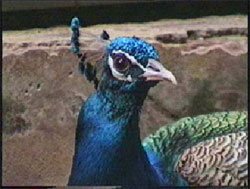 Renowned ornithologist, the Late Dr. Salim Ali, once told me that the choice was between the Indian Peafowl and the Great Indian Bustard, both big and prominent birds and typically Indian. The matter was debated in the Indian Board for Wildlife and eventually
the Indian Peafowl was selected and recommended to the Government, not only on account of its widespread distribution in the country but also because of its longstanding association with the life and culture of the Indian people. Somehow, this latter aspect
is taken for granted and it is generally not appreciated that in no other country of the world the bonds between the national bird and its people are as ancient and intimate as in India. Renowned ornithologist, the Late Dr. Salim Ali, once told me that the choice was between the Indian Peafowl and the Great Indian Bustard, both big and prominent birds and typically Indian. The matter was debated in the Indian Board for Wildlife and eventually
the Indian Peafowl was selected and recommended to the Government, not only on account of its widespread distribution in the country but also because of its longstanding association with the life and culture of the Indian people. Somehow, this latter aspect
is taken for granted and it is generally not appreciated that in no other country of the world the bonds between the national bird and its people are as ancient and intimate as in India.
Another remarkable attribute of the Indian Peafowl is its amazing adaptability. It belongs to the Pheasant family, of which there are 17 species in India, which means one-third of the world’s total number of 51 pheasant species. All of them are essentially
birds of the jungles and mountains. While the Indian Peafowl prefers scrub forest for its habitat and is distributed widely through the country, it is the only pheasant species that is able to adjust easily to human beings and is at home near habitations and
even in urban areas. This is another factor that has facilitated its long and intimate association with the people in India.
For sheer attractiveness, adorning ability and adaptability, the Indian Peafowl is clearly unsurpassed and incomparable. No other bird can claim such a triple ‘A’ standing. Regal and resplendent, yet common and plebian, it stands in a class of its own, a
true symbol of India in all its beauty and colourful splendour. It is rightly theNational Bird of India.
( Photograph; Susan Sharma)
-To be continued
|
Gardening for wildlife
|
 Ms.Promila Chaturvedi is a freelance landscape designer whose organization "Gardens India" undertakes a number of projects in landscaping and gardening. Ms.Promila Chaturvedi is a freelance landscape designer whose organization "Gardens India" undertakes a number of projects in landscaping and gardening.
|
 Bauhinia is named after twin French herbalists of 16th century- Jean and Casper Bauhin. Both these brothers were herbalists and worked together on the same projects. Bauhinia is named after twin French herbalists of 16th century- Jean and Casper Bauhin. Both these brothers were herbalists and worked together on the same projects.
The leaves of Bauhinia are joined at the bottom of their inner margin.
The genus belong to the family of Caesalpeniaceae (sweet pea). This genus contains about 150 species of trees, shrubs and climbers and out of which 20 species are found in Indian Sub-continent, and are cultivated in Indian gardens for their beautiful
foliage and attractive flowers.
The showy flowers have five petals and are arranged in simple and terminal racemes. Some of the species have fragrant flowers, which attracts insects as their pollinating agents.
Bauhinia corymbosa – It is a woody climber, which branches from the ground itself. Rounded twin leaves are 1-2in long and are folded at night –in namaskar fashion. Scented flowers appear from April to June, which are
white having pink veins. Fruits come in winter.
This beautiful climber is native of China; but now grown all over Indian gardens. It s propagated by layering.
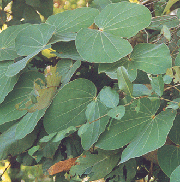 Bauhinia vahilli ( picture on right)– This is a large climber, which has small creamy flowers come in profusion on long pendulous branches. These creamy flowers fade to yellow. It blooms from April to June and fruits
appear in winter. Bauhinia vahilli ( picture on right)– This is a large climber, which has small creamy flowers come in profusion on long pendulous branches. These creamy flowers fade to yellow. It blooms from April to June and fruits
appear in winter.
It can be used as a screen, but once established, it is difficult to eradicate. And forest department considers it a menace.
It is found from north-east to north-west of Himalayan foot hills.
Bauhinia acuminata--Acuminata means sharp pointed. The leaves of this plant are sharp pointed and joined at the base. It is an erect shrub of good size, which bears white flower from March to May. Pods come in December.
It starts flowering even when only one foot high. Easy to cultivate, and usually cultivated by seeds.
It originated in Central India, Malaysia , China and Sri Lanka.
Bauhinia blakeana—Hongkong Bauhinia— It is a small tree with irregular crown and sparse branches. It grows from 6 to 10 m in height. The large leaves of this tree are rounded and are joined at the base.
This is most brilliant coloured bauhinia with very big (15cm) sweet scented wine-red flowers. It blooms from November to March but it does not set seeds.
Because it is sterile plant it has no seed pods and can be propagated by cutting and layering.
As it’s name signifies it is originated in Hongkong.
Bauhinia candida—This beautiful tree grows 6-8m high. It sheds its leaves in winter and blooms in leafless condition. The flowers, which are scented, come in profusion from December to March, and they are white with
yellow centre.
Bauhinia galpini ( picture on top of page) —It is a beautiful shrub which grows up to 2m high. It has small leaves and very beautiful shocking crimson flowers which come in such profusion that cover the whole plant and
leaves becomes invisible. It flowers in September- October and fruit in December. It can easily be propagated by seeds.
It is indigenous to Africa. Now successfully grown all over in Indian gardens.
Bauhinia monendra—It is a small tree which grows to a height of 34m. Its pink flowers have splash of red and orange on its petals. It blooms during summer months.
Bauhinia hookeri—This small slow growing tree comes to bloom after seven years of wait. Its white flowers have pink margins.
Bauhinia Petersiana—It is large spreading shrub. Its leaves are small and flowers are pale yellow. It blooms almost round the year.
Bauhinia purpuria—This is almost evergreen tree of moderate height. Its large scented flower sare rose purple in colour and bloom during September to December. Seed pods ripe in February March.
It is cultivated by seeds, and is a native of China and foot hills of Himalayan region. But it is grown successfully in the gardens all over India.
Bauhinia sulfuria—A tall shrub which have pale yellow flowers of average size. It blooms almost all round the year.
Bauhinia tomentosa—It is a beautiful shrub which grows some times into a small tree. Its sulfur yellow flowers have red throat. It flowers from August to October and fruits set in during December.
It is grown by seed sowing in April.
It is indigenous to India and China, and now grown in hotter parts of all the continents.
Bauhinia variegata—This beautiful medium size tree grows up to the height of 10m. It sheds its leaves in winter and Georget pink flowers appear from February to April.
It has medicinal as well as commercial value.
It is found wild from sub-Himalayan Region to Burma and China. And now cultivated through out India.
|
Lesser mammals
Dr. SHOMITA MUKHERJEE
 graduated from St. Xavier’s college, Mumbai in 1987 in Zoology, Biochemistry and Entomology. For her post graduation she joined the Wildlife Science course at the Wildlife Institute of India in 1988. Her Master’s dissertation was
on three small carnivores, the jungle cat, fishing cat and golden jackal in Keoladeo Ghana National Park, Bharatpur. After post graduation, she went on two surveys, one to Arunachal Pradesh to look for the Takin and the other to the Dang forests of Gujarat
for the rusty spotted cat. Her other research projects include standardizing laboratory techniques to study large carnivore diet at the Wildlife Institute of India and studying diet and habitat use in jungle cat, caracal and golden jackal in Sariska Tiger
Reserve. The latter led to her Ph.D. degree. She had a short stint at the Policy Research Cell at the Wildlife Institute of India and was later employed by the Wildlife Trust of India, Delhi and Tiger Watch, Ranthambhor. Currently she is writing a proposal
that aims to explore the utility of non-invasive DNA analysis in addressing questions related to small carnivore ecology. Though her chief interest lies in the ecology of small cats, she is also planning a project on the leopards of Sanjay Gandhi National
Park in Mumbai along with some other friends. graduated from St. Xavier’s college, Mumbai in 1987 in Zoology, Biochemistry and Entomology. For her post graduation she joined the Wildlife Science course at the Wildlife Institute of India in 1988. Her Master’s dissertation was
on three small carnivores, the jungle cat, fishing cat and golden jackal in Keoladeo Ghana National Park, Bharatpur. After post graduation, she went on two surveys, one to Arunachal Pradesh to look for the Takin and the other to the Dang forests of Gujarat
for the rusty spotted cat. Her other research projects include standardizing laboratory techniques to study large carnivore diet at the Wildlife Institute of India and studying diet and habitat use in jungle cat, caracal and golden jackal in Sariska Tiger
Reserve. The latter led to her Ph.D. degree. She had a short stint at the Policy Research Cell at the Wildlife Institute of India and was later employed by the Wildlife Trust of India, Delhi and Tiger Watch, Ranthambhor. Currently she is writing a proposal
that aims to explore the utility of non-invasive DNA analysis in addressing questions related to small carnivore ecology. Though her chief interest lies in the ecology of small cats, she is also planning a project on the leopards of Sanjay Gandhi National
Park in Mumbai along with some other friends.
“The naming of cats is a difficult matter.
It isn’t just one of your holiday games;
You may think at first I’m mad as a hatter
When I tell you, a cat must have THREE DIFFERENT NAMES…..”
So said T. S. Elliot *, and how right he was. Though he was referring to our sometimes friendly neighbourhood cat, this also applies to its 36 wild cousins. While not exactly what Elliot meant, they do have three names: the generic,
specific and common. Many a taxonomist has torn his/her hair over getting cat taxonomy right. Why do cats baffle us?
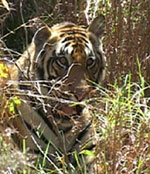 The order Carnivora (meat eating mammals), has 10 Families e.g. Canidae (dogs), Felidae (cats), Herpestidae (mongoose) etc., with many also including large quantities of fruits and seeds in their diet. However, the family Felidae
is unique, with all its members being “obligate carnivores” that cannot survive without meat. With their peculiar physiology they rely on meat for certain nutrients that other mammals like us assemble within our body with precursors. Their diet is high in
protein and fat with almost no carbohydrates while their body, skull and teeth shaped to extreme specialization, function exclusively to kill. The order Carnivora (meat eating mammals), has 10 Families e.g. Canidae (dogs), Felidae (cats), Herpestidae (mongoose) etc., with many also including large quantities of fruits and seeds in their diet. However, the family Felidae
is unique, with all its members being “obligate carnivores” that cannot survive without meat. With their peculiar physiology they rely on meat for certain nutrients that other mammals like us assemble within our body with precursors. Their diet is high in
protein and fat with almost no carbohydrates while their body, skull and teeth shaped to extreme specialization, function exclusively to kill.
One striking feature about this family is that though sizes vary almost 200 fold (the 1 kg black-footed and rusty-spotted cats to the 200 kg tiger and lion) the general appearance is the same. Anyone can tell that a tiger is just an
enormously large cat. This, some scientists believe is an outcome of their extreme specialization. Though canids and felids have diverged around the same evolutionary time scales and currently have around the same number of species (Canids: 35, Felids: 36),
cats have retained their likeness while dogs come in many forms with some hardly resembling “dogs” (I mean species and not breed -though even here dogs have so much more diversity in form that cats do)!. This could be one of the features responsible for agonizing
taxonomists.
Indians should be proud of the fact that as a country we are the richest in cat species, having 15 of its members. All except the jungle cat figure in Schedule I of the Indian Wild Life Act. What we certainly should not be proud of is
the fact that most (if not all) felids in India are threatened by habitat loss, poaching or both. We drove the cheetah to extinction and by our apathy promise to do so with its other relatives as well. Little is known of most wild felids we have in our country.
Unless appallingly ignorant, everyone has heard of tigers, lions and leopards but even the most educated may not have heard of the caracal, the rusty spotted cat or for that matter the most common wild felid in India – the jungle cat. My next article will
be dedicated to this intriguing species.
( photo: Tiger in Kanha National Park, Susan Sharma)
* T.S. Elliot (1939). Old Possum’s book of practical cats. Faber and Faber Limited, London.
|
News and Views
NEWS…………….
“Wildbytes” has completed three years of publication and we would like to thank all our contributors heartily. Keep writing and sending in your articles. IndianWildlifeClub.com tries to bridge the gap between the wildlife scientist
and the common man. Our contributors are people who have had valuable research experience or field experience in dealing with animals/birds/plants. Do read about them by clickingHERE.
We have also archived all the back issues of “Wildbytes” along with other knowledge bits by way of online quiz and online chatlogs. Premium members can access and search this archive. To become a premium member clickHERE
and VIEWS……………….
( heard at the Yahoo club
http://groups.yahoo.com/group/indianwildlifeclub2/ )
Droplets of Love
The first droplets, the fresh scent of earth.... The landscape of KUTCH is
once again live with beautiful wildflowers, grasses, birds insect.... Humans....
Like us....
Mother earth heard the peacocks on the roof calling out to the August rains
the clouds loomed on the horizon the thunder and the peacock's cries brought
children into the streets with the first drops falling and the rising smell of
newly wet earth in the rain soaking them dancing where the birds spread out
their tails with the eye of god upon them calling she began to understand
mounting the peacock's back flying up into the storm among lightning bolts and
the rising smell of the thirsty earth drinking this the monsoon season's first
rain. Like the blessings from above, the clouds sprinkle what is fondly referred
as the "droplets of love."
Mother Earth tenders her blessings in the form of a seductive smell rising
from the soil. Mating calls of peacocks gleefully blend with their amorous
dances to attract the peahens. Children rush out into the streets, catching the
first raindrops in their open mouths. The view of BHUJIA HILL is just like
heaven on earth ... The beautiful fort bathing in the first rain droplets.. The
fog gathers around the hill... The White-breasted kingfisher calling out his
song a loud... The white-throated munia flock resting on caltropic's tree..
Extracts from posting by
-Arpit Deomurari
Network And System Administrator
K-Link, Kutch Nav Nirman Abhiyan
Dr. Rajaram Campus, Nr. St. Xavier's School
BHUJ-370001
Gujarat(INDIA)
|
Zoo
 |
Toby Ninan retired from Delhi Zoo about two years back. With his varied experiences with the wild animals in the zoo, he is the right person
to direct your queries to. Hear what Ninan has to say about his life and chosen career! |
The demand for birds as pets in the west fuels an illegal trade in the wild birds here in India and ever so often we at the Delhi Zoo would be playing host to large numbers of birds caught by customs and the wild life department at
the airport. This is not necessarily a one way traffic. Not too rarely, we do get birds meant for homes of the very very rich especially richly coloured parrots and parakeets.
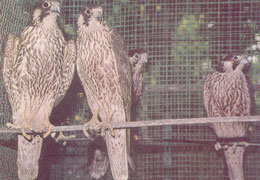 The birds going out of the country are always sent in very small containers to save on freight and also to maximize the numbers being sent at one go ( ergo increasing profit margins! ) So much so there is usually a mortality margin
of about 20% at the receiving end but since the birds are acquired at a very small cost the mortality does not matter to the traders. The "kabootarwallahs" or birdcatchers are people living at the lowest end of society mostly tribals well versed with the forest.
They are paid so very little that too as and when the dealer feels like paying them. These bird catchers are more often given some rice or other cereals which is of the lowest quality. The bird catchers live in constant fear of being caught by forest officials
and other law enforcement officials who would be usually more interested in getting bribes rather than enforcing the law. Their work is skilled and very hard as they have to be at it for long hours. The birds going out of the country are always sent in very small containers to save on freight and also to maximize the numbers being sent at one go ( ergo increasing profit margins! ) So much so there is usually a mortality margin
of about 20% at the receiving end but since the birds are acquired at a very small cost the mortality does not matter to the traders. The "kabootarwallahs" or birdcatchers are people living at the lowest end of society mostly tribals well versed with the forest.
They are paid so very little that too as and when the dealer feels like paying them. These bird catchers are more often given some rice or other cereals which is of the lowest quality. The bird catchers live in constant fear of being caught by forest officials
and other law enforcement officials who would be usually more interested in getting bribes rather than enforcing the law. Their work is skilled and very hard as they have to be at it for long hours.
Among the worst sufferers in the captive population are the munias as these not only suffer greatly due to being cramped up in very small cages but also are coloured by cheap dyes so as to enhance their saleability. After a couple of
washes the red coloured munia may turn out to be a house sparrow! More often these birds die soon and the process of capturing, and caging is repeated.
When most birds are captured they would be kept in pretty big baskets but soon they are shifted to very small cramped cages to await their long flight usually abroad. If the consignments get caught at the airport they end up in holding
enclosures which are quite large as it would be cruelty to keep them in small crates for any period of time. This however leads to birds being released from small cages flying around wildly and thus expending a lot of energy- often too much energy and excitement
result in large number of deaths at this stage!
Birds being kept in large numbers have to be closely monitored to see that all are feeding and being watered adequately so that the slightest drop in care could also result in many losses. When faced with a captured consignment of small
birds, it turns out to be a challenge and a heart break to zoo managers who have so many other jobs to attend to.
There is however a good side and a large number of birds like the hill mynah could be used to exchange for other birds which zoos may posses or when exotic birds coming into the country are confiscated –these could be used as breeding
stock to increase the variety at the zoo. Again all this entails a lot of hard and dedicated long hours of hard work. Heating or cooling and special conditions of weather have to be created along with the provision of special foods and vitamins and trace element
supplements.
As most of the time these are sent out on the sly there could be even carriers of diseases with which the whole process would become very much complicated and some times result in a complete wipe off.of the birds
Social and family jobs are neglected and nocturnal outings to look after these “guests” become the order of the day. It however increases the watchfulness of the security staff as they have to be more aware of the “ sahibs “on
frequent night prowls and have to forget catnaps of the night.
The heartbreak comes when the birds die in large numbers despite our best efforts!
( Picture of the rampant eagle trade, by Shailesh Mule of Mid-Day News paper)
|